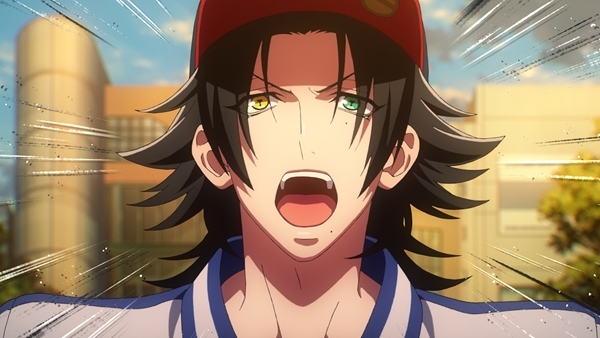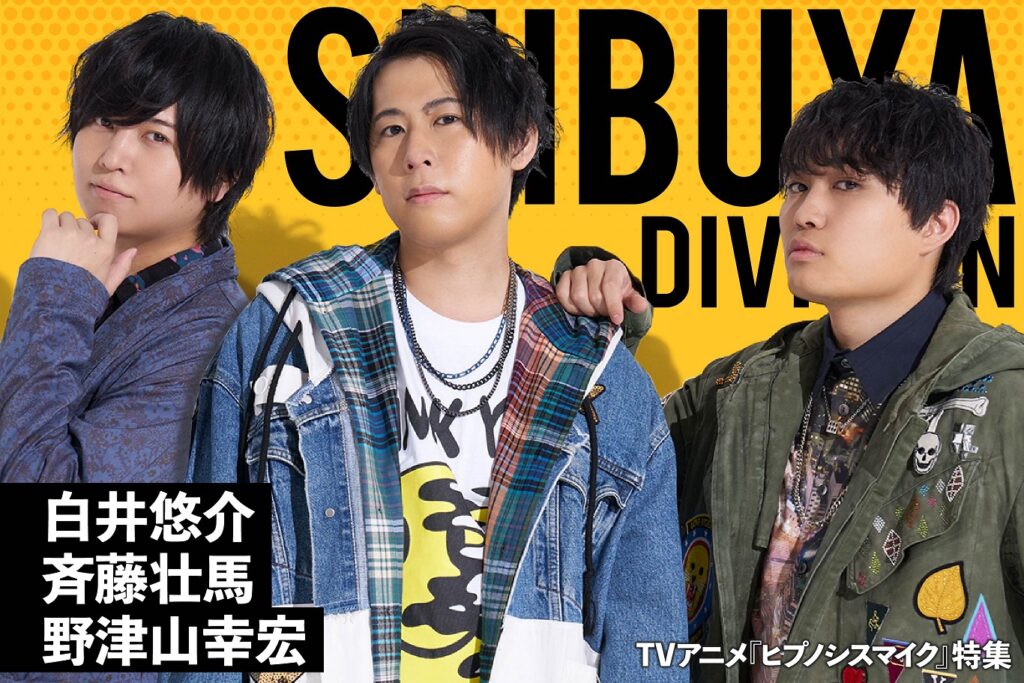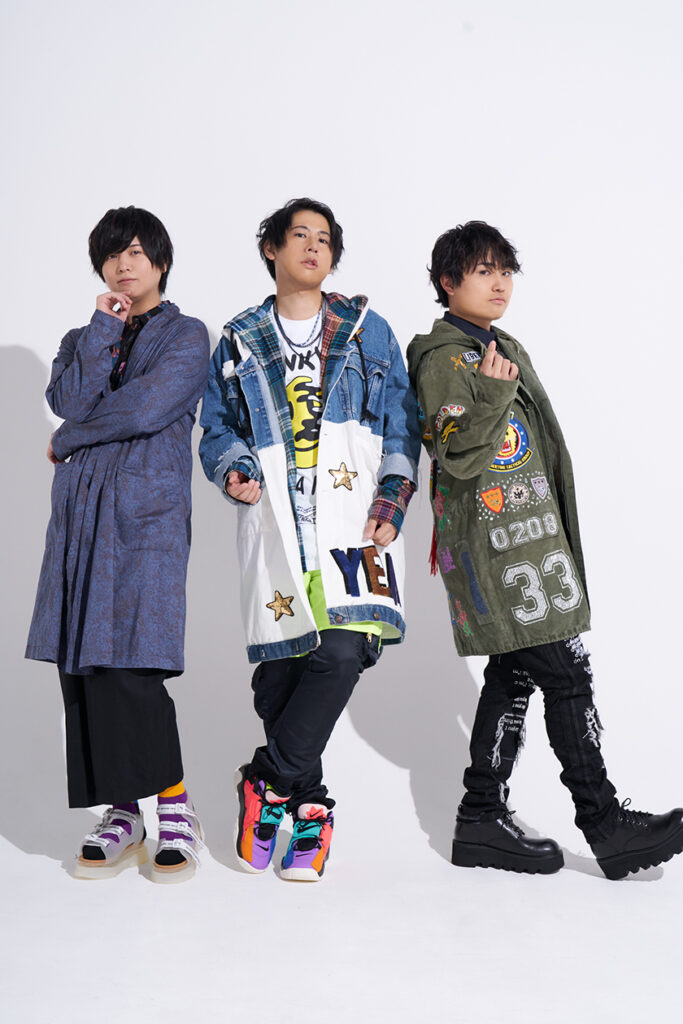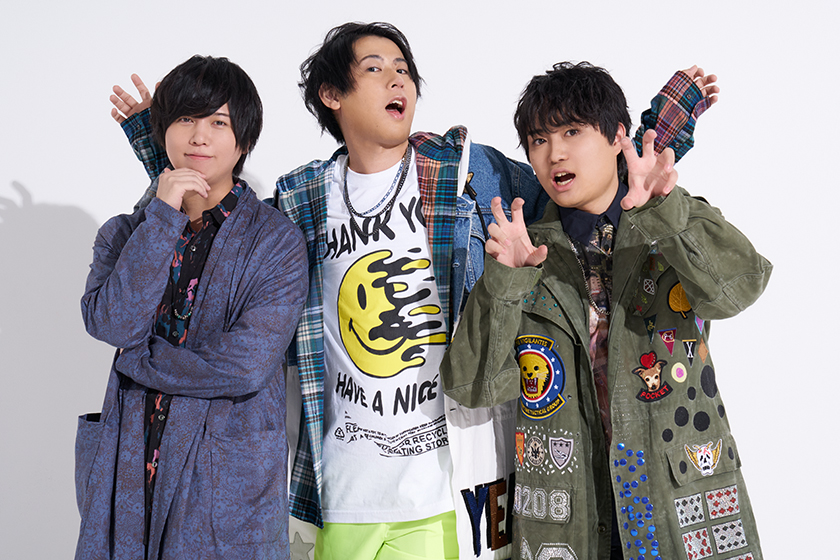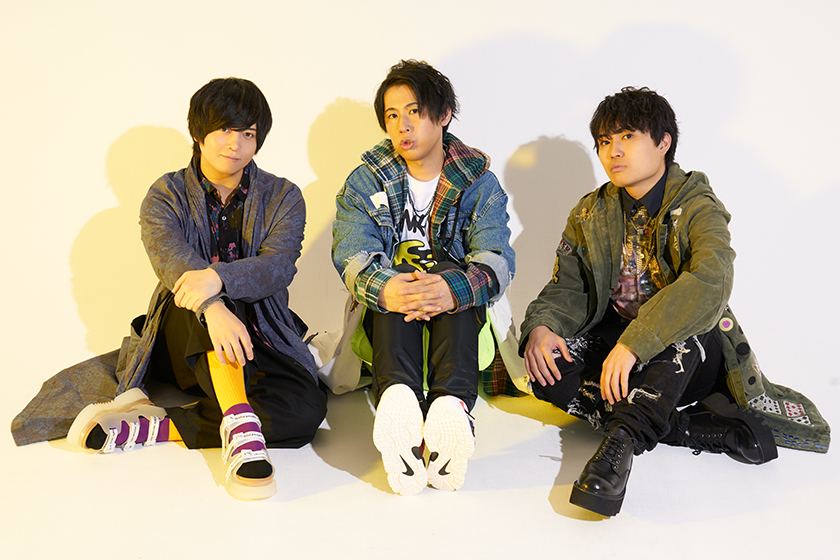(character visuals only; no scans)
Released: 2020/12/10
Features:
Saito Soma (Yumeno Gentaro in Hypnosis Mic)
Mentioned:
Shirai Yusuke (Amemura Ramuda in Hypnosis Mic)
Nozuyama Yukihiro (Arisugawa Dice in Hypnosis Mic)
Kimura Subaru (Yamada Ichiro in Hypnosis Mic)
Shibuya is like a multicoloured marble pattern
—What is your impression of Shibuya Division’s “Fling Posse” after the anime episodes that have aired so far?
Now that they’ve been animated, I have a better understanding of all of the characters’ quirks, not just Shibuya’s. Shibuya’s bright, upbeatness stands out more in visual form. In the original drama tracks, Amemura Ramuda had a gap between his cutesy side and his dark side, and I think his cutesy side comes across more strongly in the anime. When he’s scared or laughing, his face is very expressive, which is great.
—What about Arisugawa Dice?
Shibuya’s stories tend to begin with Dice’s gambling problem, so in that sense, he might be a character that pushes the story forward. Although he’s always losing the bets *laughs*. He thinks he’s pushing Ramuda and Gentaro around, but it’s actually the other way around, which makes sense at his age. The anime adds movements and reaction voices that power up that lovable cuteness of his.
—What about the character you voice, Yumeno Gentaro?
Gentaro’s physical movements and gestures are more restrained than the other two characters’. I think the contrast between the “active” two and the “calm” Gentaro is interesting. Gentaro’s always changing his personal pronoun, and since he doesn’t move much, the unconventionality of his words stands out even more. The three of them continue to be free spirits in the anime. Even though they’re all facing different directions, they come together as a team. The anime depicts that nicely, so it’s fun to watch and I feel happy seeing it.
—The visuals also become colourful when they’re on screen.
They have a lot of colours, so they pop out, right? Gentaro wears traditional Japanese-style clothes and he’s a writer, so Japanese-style effects are used for him. But since Shibuya has that colorful pop aesthetic, he doesn’t feel out of place. You can feel how the streets of Shibuya allow for a wide variety of colours to mix together in a marbled pattern.
—The battles are very flashy too.
The battles in the anime have flashy visuals, and the direction includes both coolness and humour. For example, when you watch their battle with Shinjuku Division’s “Matenro” in Episode 10, you might think, “Hifumi’s verse is so cool!”, or you could look at Gentaro taking his attack and think, “Why is his entire body wrapped in roses?!” It’s great how the anime allows for different types of enjoyment. We’ve been rewatching the aired episodes over and over for work, and depending on who I watch them with, the topics and perspective of the conversation change. Rap was originally for expressing your thoughts through words, but it also contains the fun of playing with words and joking around. I think that the anime’s insert raps have a really good balance between those.
—It was notable how Dice and Gentaro joined in on Ramuda’s enthusiasm during battles and the concert in Episode 5.
When Ramuda responds to the other side’s provocations and picks up his mic, Dice and Gentaro immediately follow suit. It’s nice, right? The way they go “Ramuda! Dice! Gentaro!” as if to say “Fling Posse is here!” feels like they’re in a shounen manga. Shibuya’s cast members often talk about how nice the shounen manga feeling of this franchise is. For example, in the original drama CDs, when Ramuda is in trouble, Dice and Gentaro run over to help him. It’s orthodox, but it’s really moving, right? I think it’s amazing that Shibuya, which seems to lack unity at first glance, can be responsible for that shounen manga feeling.
—The division battle began in Episode 9, and Episode 10 depicted the fight between Shibuya Division and Shinjuku Division. This insert rap was unique from the others because it was in the format of a rap battle.
Right. They’d battled people before, but those raps were one-sided attacks and didn’t show the enemies fighting back. In Episodes 9-10, the divisions exchange blows using words, and it feels good to see and hear the back-and-forth. In Episode 10, Shibuya continues to have the same bright and colorful depiction that they did in the previous raps, but I like how it’s mixed with Shinjuku’s mysteriousness. There was also the indescribable surrealism of combining Jakurai-sensei with a gift box…
Sound-wise, since it’s a battle between divisions with different styles, even though the BPM is the same throughout, the different arrangements of the beats result in opposite effects. As with previous songs, Shibuya has a lot of beats that come in on tension chords and a melodious flow. Even in a serious battle, if it’s Shibuya singing, it comes out cheerful and fun.
—Shibuya Division attacked relentlessly, but just when it seemed like they won…
Ramuda riles up Shinjuku when they’re down and they lose to Doppo losing his temper and counterattacking. The sudden development makes you wonder if Shibuya would’ve won if Ramuda hadn’t provoked them…
Of course, it’s a shame that they lost, but I think Shibuya gained something more important from it. These three aren’t related by blood, nor have they known each other since long ago. Their team was formed so that Ramuda could complete his objective. So at first, they had no sense of unity and were all doing their own things. But in this battle, they all faced the same direction with a clear, shared objective. They still felt refreshed afterwards even though they lost. The way they laid on the ground looking up at the sky really felt like a scene from a shounen manga. In that sense, it was a good, worthwhile fight.
—Ramuda was ordered to use the real hypnosis mic in this battle, but the moment he tries to, Dice and Gentaro stop him even though they shouldn’t know what it means. Why do you think they did?
Why did Gentaro and Dice stop him, and what were they thinking? I have my own interpretation, but I think it would be better to let the viewers think about it some more. What I can say is that Gentaro’s lines in this part were said in a more over-the-top way than normal. The intent behind that will be made more clear in Episode 11 and beyond.
—Shibuya Division’s other episodes were Episode 5 and 8.
I think Episode 5 was very Shibuya-esque. The Halloween aesthetic really matches them, and it made me realize that Shibuya can blend in with any colours.
—It was funny how Ramuda was afraid of ghosts.
Up until then we hadn’t seen Ramuda outright terrified, so we got to know a new side of him. It was also great how Dice said he wasn’t scared at first, but gradually got caught up in the atmosphere. I liked Shibuya’s scenes in Episode 5, but what I liked more was the scene where Rex heroically takes a bite out of the squid jerky. Tom, Iris, and Rex were the only audience members for Shibuya’s concert, and I never expected them to be sitting on the floor, eating squid jerky… The three of them are anime-original characters, but they have a nice, loose vibe. When they eat delicious things, they talk about the deliciousness with a straight face.
—Aside from Tom’s group, the other anime-original characters also have strong personalities.
Exactly. It’s fun how there are so many things to poke fun at. The dialogue with Space Colony, who Shibuya faces in Episode 5, was entertaining too. Ramuda reveals Space Colony’s plot and says, “We won’t fall for that trick,” and Space Colony admits to it right away. Don’t you think they gave in too quickly? And then they follow up by trying to recruit Fling Posse—there’s just too many things to question *laughs*. The sub-characters are so energized that I need to make my quips at a fast pace if I want to keep up. Thanks to that, the story is denser and the half hour goes by in a flash.
—How was the rap in Episode 5?
It’s an enjoyable song with an 80s style beat. Recently, the music scene in general has been going through a modified 80s revival. This song has that “old yet new” feeling as well. I also like how the music sounds and the ghostbusters theme of the lyrics—they’re very “Shibuya.”
—In Episode 8, Dice lost a bet and fell for a trick. He loses a bet every time he appears, huh?
Yeah. Even among the cast, we said, “Dice did it again…!” The Episode 8 rap had a different atmosphere from anything Shibuya had done before, which was refreshing. Since it was a battle to save Dice from the casino that tricked him, the beat is aggressive. I think it’s the first time we’ve had an aggressive song since “BATTLE BATTLE BATTLE” from the original dramas. Even though the beat is aggressive, the rap itself isn’t rapidfire. The word count is low and I sang while thinking about how to add weight to each and every word. It was difficult, but that’s what made it fun. Also, Gentaro’s line right before the song…
—You mean, “I simply despise lies!” ?
Yep. Gentaro was extremely angry, right? This line was recorded at a recording session that took place before the actual episode recording. I thought that kind of Gentaro might work too, so I tried it, and it was used. I actually forgot I’d recorded that line, and when I heard it again at the episode recording, I was surprised by how sharp it was *laughs*. The line itself wasn’t wrong, and the song was really cool too, but… it seems a bit funny, right? Gentaro’s twisted sense of humour is on full blast in this scene. I hope you think of it as part of what makes him who he is.
The surreal laughter at the recording sessions
—What did the cast talk about at the recording sessions?
The three Shibuya members often recorded together, and we often broke out into surreal laughter. To give an example from a recently aired episode, at the Episode 10 recording, Shirai-san absentmindedly said, “100,000 luckies… What’s that?” It’s true that we don’t know where the number 100,000 came from or if it’s considered big or small, so we burst out laughing at Shirai-san’s sudden remark. Also, at the end, when Ramuda looks up and says, “Today is a good day to die”—he’d been saying it the way you heard it in the broadcast version, but during the recording, he suddenly said it in the dark Ramuda’s low voice instead. The sound director gave him an indifferent, “That’s wrong,” and Nozu and I chuckled *laughs*. It’s not like we’re always playing around, but someone will say something kind of funny out of nowhere that makes us laugh. I love that kind of surreal atmosphere, so I had fun at every recording session.
—The ending theme for Episodes 7-9 were Shibuya Division’s “Kizuna -SHIBUYA ver.-” The verse lyrics were written by Yanosuke, who also wrote the lyrics for “Stella.”
That’s right. The other division’s lyrics were also written by artists who’d been involved with their music, and Shibuya’s was Yanosuke. The verse and the lyrics exuded Shibuya’s mellowness. The chorus is shared with the other divisions, but since Shibuya doesn’t have any characters with low voices, it feels like pop music.
The “Kizuna” line has many layers of voices. The attack-like “na” at the end is really powerful, right? I think the most audible “na” is probably my natural voice. When I was recording the layering voices, I did Gentaro’s voice of course, and I also did my natural voice as part of the background crowd.
A mellow verse, an upbeat chorus, and a powerful attack made up of different layered voices—all of these elements combine into a Shibuya-esque song.
—What should we look out for in the rest of the anime?
Shibuya lost their battle, but they’ll continue to be part of the show. They’ll actually kind of be operating behind the scenes, so I hope you’ll look forward to that. Chuo-ku was clearly angry at Ramuda for choosing not to use the real hypnosis mic in Episode 10, so please watch to see what becomes of that. There’s drama going on at the same time as the final battle, and I hope you’ll enjoy the climax.
—Lastly, a message for the readers.
Hypmic began with music CDs, and now it’s expanded into comics, stage plays, and a game. It’s wonderful how there are so many different entry points. It’s good to enjoy one of them in depth, but it’s also interesting how the characters are depicted in each medium. I believe there are also people who are experiencing Hypmic for the first time through the anime. I hope you’ll take this opportunity to enjoy the other Hypmic media too.
About the Music of Hypmic
—The anime introduced many new songs. What did you pay attention to when expressing Gentaro’s nuances?
I think the approach differs depending on the character. In Gentaro’s case, since he’s MC Phantom, I try for a fluttering feeling, as if swirling smoke around the target. He often has a crafted flow that intentionally strays from the rhythm in a meandering way. But that said, I can’t actually meander, so it’s a tricky balance. He acts calm and collected, but I think he would switch gears in a serious fight like Episode 10, so I tried to add more emotion to his usual elegance. All of the songs are difficult, so I’d practice at home a lot before the recording. Also, Gentaro changes his voice even in normal dialogue, so I can change my tone of voice in the middle of songs as well. This means I can try out a lot of things, and I’d like to continue using different approaches to Gentaro.
—Hypmic’s songs have been getting more and more difficult since the original drama CDs.
Indeed. The difficulty is rising, and I assume the other cast members are struggling too, but at the same time, I’m sure they’re having fun as well. When you keep trying over and over until your rap fits the music cleanly and produces a good result, it feels good in your heart, mouth, and body. That exhilaration is something we can only experience because it’s rap.
—Before, when we had Colabintaro-san explain the insert raps in the original drama CDs, he said, “We have Saito Soma-kun attempt difficult raps for us.”
Many of Gentaro’s songs use a storytelling tone, like his solo song “Scenario Liar.” I do like that, but I also talked to Kimura Subaru-kun about how I wanted to try something aggressive like Dice’s songs, although I didn’t know how far I could go with it as Gentaro. Perhaps that message got across to Bintaro-san, because I’ve been able to do different variations now.
((Note: Colabintaro is Kimura Subaru’s alias that he uses when writing lyrics for Hypmic.))
—Is it fulfilling?
It makes me really happy when someone writes a song for me thinking, “I want you to sing this.” Even if it’s a difficult one, practicing it gives me more tools at my disposal.




















